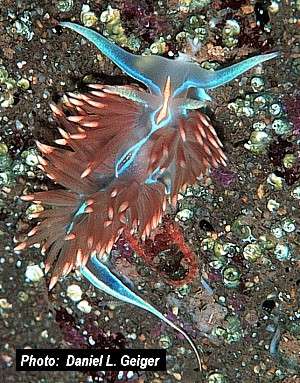
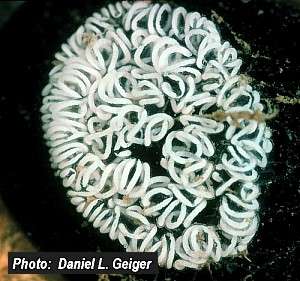
Hermissenda crassicornis
(Eschscholtz, 1831)
Order: NUDIBRANCHIA
Suborder: AEOLIDINA
Family: Glaucidae
DISTRIBUTION
West Coast of North America from Kodiak Island, Alaska to Baja California, Mexico. NW Pacific - Japan and Sth Korea (Behrens & Hermosillo, 2005; Sea Slug Forum records).
PHOTO
UPPER: Monterey Bay Aquarium, California.
LOWER: Egg ribbon, Los Angeles, California.
PHOTOS: Daniel L. Geiger.
The body is translucent clear with a very characteristic pattern of white or bluish-white lines, yellow-orange patches and bluish white dusting. The upper half of both the oral tentacles and the rhinophores are dusted with white. A opaque white line runs from the tip of each oral tentacle down the posterior edge of the dorsal surface of the tentacle to the head. Here it splits in two, one branch running up to join its partner from the other oral tentacle to run down the dorsal midline to the posterior tip of the body. The other branch runs along the edge of the mantle, with breaks between the ceratal clusters. The white lines running between the rhinophores join just behind the rhinophores, then separate again in the interhepatic space behind the first ceratal cluster. They join again about halfway down the body to run as a single line to the posterior tip of the body. There is a bright orange median line [sometimes white yellow or red] which runs from between the rhinophores, forward about halfway across the head. A shorter line of the same colour lies in the interhepatic space between the two white lines. There is also a white line running along the edge of the foot. There is some colour variability in this species, the white lines in particular, can appear quite blue, and sometimes they are a broad faint band, other times there can be a thin intense white line with a broad band of white dusting running alongside. The ceratal colour can also vary. Usually the digestive gland is a shade of brown and the cerata are tipped with white and may have a subapical band of orange. One variety has a white line up each ceras. In others, the ceratal color is faded, forming bands of white and brown. The rhinophores range from almost smooth to slightly wrinkled. In some cases quite distinct rings can be present. It grows to about 50 mm.
References:
• Avila, C. (1999) Chemotaxis in the nudibranch Hermissenda crassicornis: does ingestive conditioning influence it behaviour in a Y-maze? Journal of Molluscan Studies, 64: 215-222
• Avila, C., Tyndale, E., & Kuzirian, A.M. (1998) Feeding behaviour and growth of Hermissenda crassicornis (Mollusca: Nudibranchia) in the Laboratory. Mar. Fresh. Behav. Physiol., 31: 1-19.
• Behrens, D.W. (1980) Pacific Coast Nudibranchs. A guide to the opisthobranchs of the northeastern Pacific. Sea Challengers. Los Osos, California.
• Harrigan, J.F. & Alkon, D.L. (1978). Larval rearing, metamorphosis, growth and reproduction of the aeolid nudibranch Hermissenda crassicornis (Eschscholtz, 1831). Biological Bulletin, 154: 430-439.
•Longley, R.D. & Longley, A.J. (1981) Hermissenda: agonistic behaviour or mating behaviour? The Veliger 24(3):, 230-231.
•Rutowski, R.L. (1983): Mating and egg mass production in the aeolid nudibranch Hermissenda crassicornis (Gastropoda: Opisthobranchia). Biological Bulletin, 165(August): 276-285.
Rudman, W.B., 2003 (August 2) Hermissenda crassicornis (Eschscholtz, 1831). [In] Sea Slug Forum. Australian Museum, Sydney. Available from http://www.seaslugforum.net/find/hermcras
Related messages
Hermissenda crassicornis eating Flabellina trilineata
August 15, 2007
From: John Albers-Mead
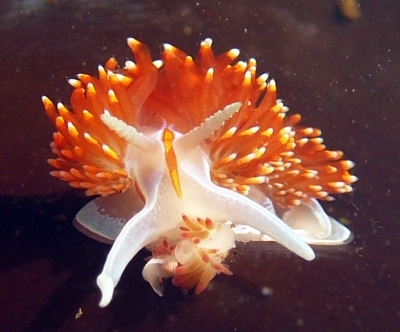

Hi Bill-
In early July I found a deep tide pool at Bean Hollow State Park in Northern California that contained 2 large Hermissenda crassicornis and about 2 dozen Flabellina trilineata. I was interested in getting images of some of them and collected one of the Hermissenda and a Flabellina in a cup. A few minutes later when I looked in the cup, I noticed that the Flabellina seemed different from when I had put it in and it wasn't moving very much. I placed both nudibranchs on an algae leaf and recorded the accompanying images of the Hermissenda proceeding to chew up the remains of the Flabellina.
Locality: Bean Hollow State Park, intertidal, Northern California, Eastern Pacific, July 2, 2007, rocky pool. Length: Hermissenda 1.75 inches, Flabellina 0.5 inches. Photographer: John Albers-Mead.
I also got some video of the event here:
http://www.youtube.com/watch?v=Tuecg6WeOE4
and posted larger images here: http://www.flickr.com/photos/jalbersmead/784174960/
John Albers-Mead
jalbersmead@gmail.com
Albers-Mead, J., 2007 (Aug 15) Hermissenda crassicornis eating Flabellina trilineata. [Message in] Sea Slug Forum. Australian Museum, Sydney. Available from http://www.seaslugforum.net/find/20455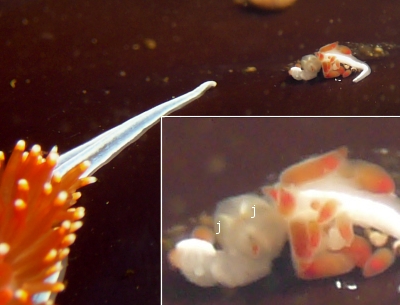
Dear John,
Thanks for this observation. Hermissenda has a reputation for not being that friendly to other nudibranchs. Looking at the 'left-overs', I see the Hermissenda has rejected the muscular buccal bulb [see inset in lower photo]. I can recognise it from the two jaw plates [j] still in position.
Best wishes,
Bill Rudman
Hermissenda vs. Corynactis
August 3, 2007
From: Bruce Wight
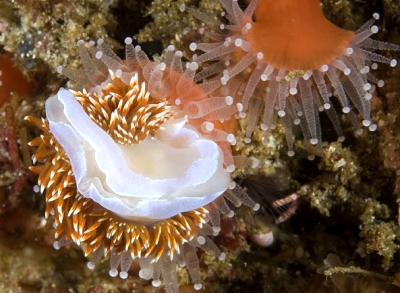
Came across what appeared to be a Corynactis californica feeding on a Hermissenda crassicornis. After a few minutes the struggle was over and the Hermissenda crawled away leaving a few cerata behind.
Locality: San Miguel Island, 50 feet, California, USA, Pacific, 16 July 2007, Reef structure. Length: 2 inches. Photographer: Bruce Wight.
Bruce Wight
bruce.c.wight@boeing.com
Wight, B.C., 2007 (Aug 3) Hermissenda vs. Corynactis. [Message in] Sea Slug Forum. Australian Museum, Sydney. Available from http://www.seaslugforum.net/find/20317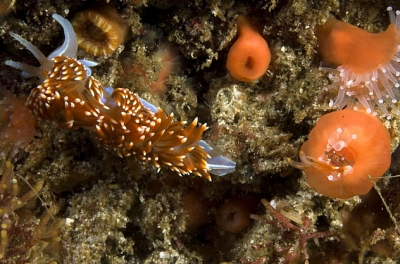
Hi Bruce,
Great observation. Between the stinging nematocysts of the slug and its ability to autotomize its cerata, it defeated a potential predator. Super defence mechanisms. Thanks especially for hanging around and documenting the whole story.
Dave Behrens
Behrens, D.W., 2007 (Aug 3). Comment on Hermissenda vs. Corynactis by Bruce Wight. [Message in] Sea Slug Forum. Australian Museum, Sydney. Available from http://www.seaslugforum.net/find/20317Nudibranch Parasite? - Hermissenda
August 1, 2007
From: Bruce Wight
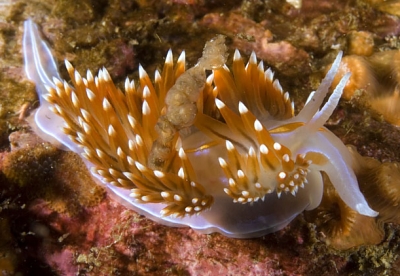
Found a Hermissenda crassicornis with a growth extending from its dorsal side in between the cerata. Do you think these are parasites?
Locality: San Miguel Island, 40-60 feet, California, USA, Pacific, 16 July 2007, On reef structure. Length: 1-2 inches. Photographer: Bruce Wight.
Bruce Wight
bruce.c.wight@boeing.com
Wight, B.C., 2007 (Aug 1) Nudibranch Parasite? - Hermissenda. [Message in] Sea Slug Forum. Australian Museum, Sydney. Available from http://www.seaslugforum.net/find/20319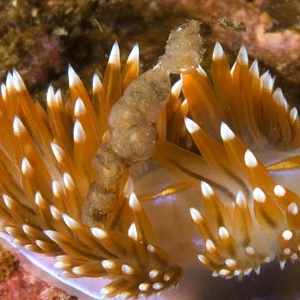
Dear Bruce,
I am happy to say that this animal is probably feeling great relief rather than great illness. To put it delicately - the mass seems to be coming from where the anus is situated in Hermissenda.
Best wishes,
Bill Rudman
Colour variation in Hermissenda crassicornis
April 4, 2007
From: Carissa Thomas
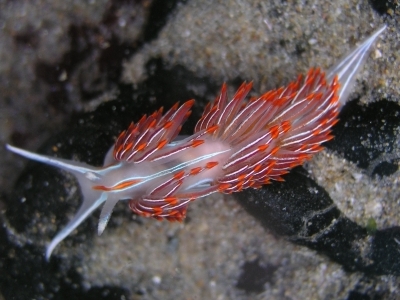
Hi there!
I recently took a trip to Neptune State Park, Oregon and photographed a nudibranch that I'm almost sure is Hermissenda crassicornis (shown in the upper photo ). Finding this one made me question the photo I had already had on file for Hermissenda. This one was taken on North Beach, Orcas Island, Washington (lower photo ). Are these just different color variations of H. crassicornis, or is one a different species?
Thanks for your help!
Carissa Thomas
Seattle, WA
Carissa.Thomas@gmail.com
Thomas, C., 2007 (Apr 4) Colour variation in Hermissenda crassicornis. [Message in] Sea Slug Forum. Australian Museum, Sydney. Available from http://www.seaslugforum.net/find/19786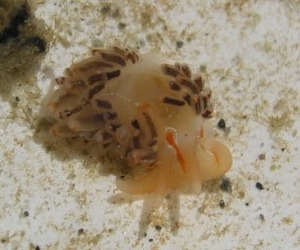
Hi Carissa,
Your identification is quite correct, as is your speculation that Hermissenda crassicornis is a variably colored species. In the first edition of "Pacific Coast Nudibranchs" I was able to present all three color extremes, which include both of yours shown here. Your top photo, showing a white line extending up each cerata to the tip, is very characteristic of the most common coloration seen in Oregon, Washington and British Columbia. Your lower photo is a juvenile, recognizable but the orange elongate rhomboid patch on the animals head outlined with a white line (in adults it would be pale blue). The third color variant, more commonly observed in the southern reaches of this species range (ie: California) has orange ceratal cores with a white tip. This is the form shown in my "Eastern Pacific Nudibranchs." All three have the characteristic lines on the head tentacles, medially to the tail, and along the margin of the foot.
Thanks for bringing this important variation up,
Dave Behrens
Hermissenda crassicornis from Oregon, USA
June 3, 2006
From: Julie Gilchrist

I noticed this curious creature in a shallow beach tidepool this weekend in Oregon.
Locality: Cannon Beach, 6 inch tidepool, Oregon, USA, NW Pacific, 30 May 2006, sandy tidepool on beach. Length: 1 inch. Photographer: Julie Gilchrist.
Any ideas on what it is?
Thanks!
Julie Gilchrist
jules@thisjourney.com
Gilchrist, J., 2006 (Jun 3) Hermissenda crassicornis from Oregon, USA. [Message in] Sea Slug Forum. Australian Museum, Sydney. Available from http://www.seaslugforum.net/find/16753Hi Julie,
Thanks for thinking of us with your request. You have found one of the prettiest aeolid nudibranchs on this coast. This is Hermissenda crassicornis. Some folks use the common name - Opalescent sea slug, but I prefer to avoid these.
Although the coloration of the cerata varies with locality, the one characteristic that is always present is the thin romboid shaped patch of orange, outlined with white, just behind the rhinophores. The white may be flanked with blue, which can also be found along the edge of the foot and medially on the tail.
This species grazes on hydroids, both in tidepools and subtidally.
Thanks
Dave Behrens
Re: Hermissenda crassicornis from Sth Korea
February 25, 2006
From: Ron Velarde
Concerning message #15925:
Hi Bill/ Koh
This report from South Korea made me curious as to the known distribution of Hermissenda crassicornis. When I went to the fact sheet, only the East coast of North America is listed. In checking Behrens (1991) and looking at the prior reports on the Forum, I think Japan and South Korea should be added to the distribution of this species on the fact sheet.
Ron Velarde
rvelarde@sandiego.gov
Ron Velarde, 2006 (Feb 25) Re: Hermissenda crassicornis from Sth Korea. [Message in] Sea Slug Forum. Australian Museum, Sydney. Available from http://www.seaslugforum.net/find/15943Thanks Ron,
I thought I had upgraded that locality data - my lapse. Thanks for letting me know, I'll make the change right now
Best wishes,
Bill Rudman
Hermissenda crassicornis from Sth Korea
February 24, 2006
From: Dong Bum Koh

Dear Bill,
Here is a beautiful photo from my friend Ok Soo Kim. The smaller one Has partially broken cerata on the left side. Is this tailing behavior before mating?
Could you give more informations for me?
Locality: Ul Jin, Gyung Book Prov., -15 m, Korea, East Sea, 23 Jan. 2005, Rocky. Length: Approx. 20~40 mm. Photographer: Ok Soo Kim.
Best regards,
Dong Bum Koh
drkoh@seasee.co.kr
D.B.Koh, 2006 (Feb 24) Hermissenda crassicornis from Sth Korea. [Message in] Sea Slug Forum. Australian Museum, Sydney. Available from http://www.seaslugforum.net/find/15925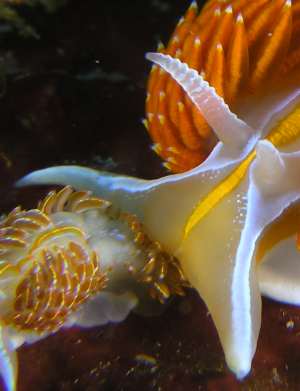
Dear Koh,
It is indeed a nice photo. From just one photo, I can't be sure what is happening, but I suspect we may be seeing the larger animal attempting to eat the smaller one, rather than attempting to mate. Cannibalistic behaviour has been observed in both juvenile and adult Hermissenda crassicornis by a number of research workers [see Avila, Tyndale & Kuzirian, 1998] has been obsrerved.
The close-up photo alongside shows the damaged ceratal clusters, and also the structure of the rhinophores
-
Avila, C., Tyndale, E., & Kuzirian, A.M. (1998) Feeding behaviour and growth of Hermissenda crassicornis (Mollusca: Nudibranchia) in the Laboratory. Mar. Fresh. Behav. Physiol., 31: 1-19.
Bill Rudman Rudman, W.B., 2006 (Feb 24). Comment on Hermissenda crassicornis from Sth Korea by Dong Bum Koh. [Message in] Sea Slug Forum. Australian Museum, Sydney. Available from http://www.seaslugforum.net/find/15925
Hermissenda crassicornis eating ascidians?
February 3, 2006
From: Marli Wakeling
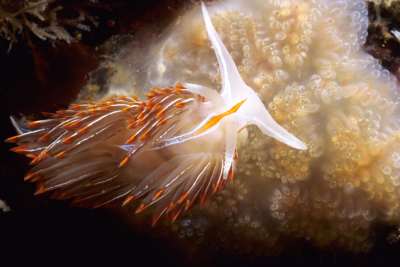
Hi Bill/Dave
Here's Hermissenda crassicornis on some ascidians. I know they eat different things; could it be eating these?
Locality: Quadra Island, British Columbia, Canada. Pacific coast. Depth: 45 feet. Length: 25 mm. 10 October 2005. Rocky wall. Photographer: Marli Wakeling
Cheers,
Marli
scubamarli@gmail.com
Wakeling, M., 2006 (Feb 3) Hermissenda crassicornis eating ascidians?. [Message in] Sea Slug Forum. Australian Museum, Sydney. Available from http://www.seaslugforum.net/find/15705Thanks Marli,
Cesar Megina's message [#1097] suggests your animal could well have been feeding on the colonial ascidian.
Best wishes,
Bill Rudman
Hermissenda crassicornis genetics
December 12, 2005
From: Martin H. Johnson
Dear Bill,
I am in the early stages of using molecular biology to study the relationship between Hermissenda crassicornis and its prey. I would like to study the immune system and try to determine how the sea slug can ingest nematocysts of Cnidarians without discharging them and without having its own immune system attack the cells. I think a study such as this could lend some information in the area of tissue rejection. Do you know of any genetic studies of this nudibranch or others? I live in Sitka, Alaska and am thinking of using Metridium senile as the Cnidarian for this study. Any references or similar studies that you know of would be a great help. I have sure enjoyed all the pictures and information on this site.
Thanks for keeping it going.
Martin H. Johnson
martyj@mehs.us
Johnson, M.H., 2005 (Dec 12) Hermissenda crassicornis genetics. [Message in] Sea Slug Forum. Australian Museum, Sydney. Available from http://www.seaslugforum.net/find/15438Dear Marty,
If you haven't already look at the relevant messages attached to the Hermissenda crassicornis Fact Sheet for more information on feeding, and the references I have cited on that page. The Avila et al (1998) paper mentions Metridium is a good food for adults but juveniles seem to need Tubularia for growth. The question of how aeolids can remove nematocysts from cnidarian and move them undischarged to their cnidosacs is indeed a fascinating story, which to my knowledge is still unsolved. The latest feeling is that nematocysts mature 'physically' some time before they are physiologically capable of discharging, and it is these physically mature but physiologically immature nematocysts which are utilised by the aeolids. One major problem is that it is still not clear how nematocysts are discharged in cnidarians! Have a look at the Fact Sheet on the Aeolid cnidosac for references to nematocysts and research on how aeolids utilise them. It is not a huge literature. If you find any further studies please let me know as it would be good to add them to the list.
Opisthiobranchs have made a habit of 'stealing' things from other organisms. Have a look at the solar powered Fact Sheet for references to those that harbour zooxanthellae and plastids. Clearly they also have found ways of defeating their own immune systems. Goos Luck with your research and keep in touch with us. I would love to hear progress reports.
Best wishes,
Bill Rudman
Re: Janolus fuscus from Puget Sound
October 5, 2005
From: Jeff Goddard
Hi Bill,
Concerning message #14896:
Unlike the specimen pictured in his lower photo [and his first message #14142], the specimen in Jack Connick's upper photo (from Little Patos Island, Boundary Pass, San Juan Islands) is a typical Janolus fuscus. There are no blue or white lines on the body or cerata, the main branches of the digestive gland are clearly visible through the body wall, and the cerata are not arranged in transverse rows. The overall shape of the body and cerata is also different from Hermissenda. Of course, Janolus also lacks cephalic tentacles and has lamellate rhinophores, but these are not visible in this photo.
Best wishes,
Jeff:
goddard@lifesci.ucsb.edu
Goddard, J.H.R., 2005 (Oct 5) Re: Janolus fuscus from Puget Sound. [Message in] Sea Slug Forum. Australian Museum, Sydney. Available from http://www.seaslugforum.net/find/14918Thanks Jeff,
Bill Rudman
Re: Janolus fuscus from Puget Sound
October 4, 2005
From: Jack Connick
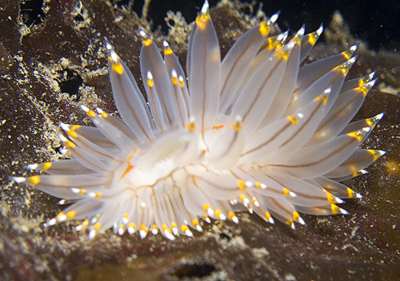

Dear Bill,
Concerning my message #14856:
I am basing my identity as Janolus fuscus from "Pacific Coast Nudibranchs" by Behrens, pg 82. It looks exactly as pictured.
Here's another shot [Upper photo] from: Little Patos Island, Boundary Pass, San Juan Islands, Washington, USA. Depth: 20 feet.Length: 2". 09 Sept 2005. Shallow ground kelp. Photographer: Jack Connick
The photos of Hermissenda you mentioned are from higher current areas of British Columbia. Where I shot the original photo [message #14142] is a deep silty area of Elliot Bay in Puget Sound, right at Seattle. It was unusual, I've never seen this nudi there before, nor had I seen it seem to eat the jellyfish, they (I saw two) were definitely interested in the jellies, it wasn't by chance they were on them.
And I still disagree that this is a Hermissenda. You can see the head clearly enough to see that there aren't the tentacles that Hermissenda has, nor the shape and pattern of the cerata. That it has a white line at it's base seems like it might be from something it ate, or perhaps an un-described sub-species of Janolus (my vote!).
I'm no biologist, but I do study these guys in the wild. I've a macro lens now and will be sure to get the head of the next one better. The lower photo is a bit better version of the first shot I submitted [message #14142 ].
Enjoy the site! If you like I'll continue to submit shots of nudis from this area that you are missing.
Jack
JackConnick@Yahoo.com
Connick, J., 2005 (Oct 4) Re: Janolus fuscus from Puget Sound. [Message in] Sea Slug Forum. Australian Museum, Sydney. Available from http://www.seaslugforum.net/find/14896Thanks Jack,
From this distance away all I can do is try and be an impartial judge. I tend to agree with the experts. Apart from the colour pattern, species of Janolus don't eat cnidarians and Hermissenda has certainly been known to. I'm afraid I can't see the head clearly in either photo - and in the lower photo the cerata seemed to be arranged in transverese rows which is characteristic of Hermissenda but not Janolus. I guess the lesson is that we can't answer all life's mysteries from a photo. I certainly hope you will continue to make contributions to the Forum.
Best wishes,
Bill Rudman
Re: Janolus fuscus from Puget Sound
September 30, 2005
From: Jack Connick
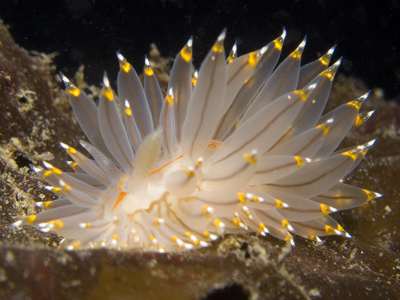
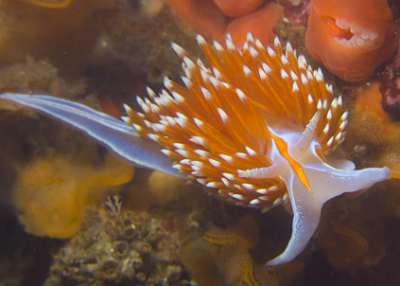
Concerning the comments [#14196] on my message. Sorry, but there is no way this was a Hermissenda crassicornis, they are quite totally different. Although Hermissenda are supposed to be in these waters, I've never observed them or seen photos taken within Puget Sound, maybe out on the coast.
I was wrong about the jellyfish, it is a "scrambled egg" jelly. maybe it was eating something on the jelly? There werre two of them seemingly doing the same activity.
I'm attaching another Janolus fuscus shot [upper ] at Little Patos Island in the San Juans near the southern Strait of Georgia. Also attached is a Hermissenda shot [lower ] at San Miguel Island, California, they are quite common in August.
Locality: [for Janolus fuscus] Little Patos Island, San Juan Islands, Boundary Pass, Washington, USA. Depth: 20 feet. Length: 2". 8 August 2005. shallow ground kelp. Photographer: Jack Connick
Jack
JackConnick@Yahoo.com
Connick, Jack, 2005 (Sep 30) Re: Janolus fuscus from Puget Sound. [Message in] Sea Slug Forum. Australian Museum, Sydney. Available from http://www.seaslugforum.net/find/14856Dear Jack,
Thanks for the beautiful photos for the 'identity parade'. I'm afraid that without the animal, or a photo of its head, there is no easy solution to this puzzle. Your photo [#14142 ], certainly looked to me like Janolus fuscus, but I have no experience of the fauna of your coastline. However Jeff Goddard, who does know the fauna well, explained why he believed it to be Hermissenda crassicornis [message #14196 ]. All I can say is that your animals had a distinct white line down each ceras from the tip, and a white line around the edge of the foot. I don't know of any Janolus fuscus with such white lines, yet we have two messages on the Forum [#11055, #11719 ] with photos of animals from quite close to Puget Sound [British Columbia] with such lines, and they are definitely Hermissenda crassicornis. Certainly Californian specimens of Hermissenda, as in your photo, look quite different from J. fuscus, but northern ones look quite quite similar
If anyone else can contribute, please do.
Best wishes,
Bill Rudman
Flabellina pricei or mistaken identity
August 9, 2005
From: Jan Kocian
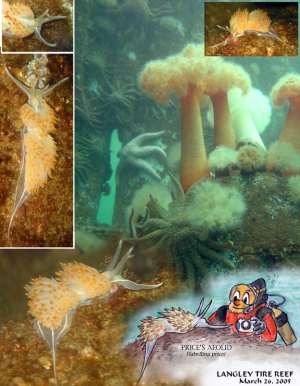
Greetings from Whidbey Island, Washington. After discovering your excellent nudibranch site I went through some older dive log pages and discovered, that the nudibranch I took pictures of back in March, and identified as Flabellina pricei are not even listed on your site, which seems to have everything. Could you please let me know what I did take pictures off, so I can correct my record?
Locality: Whidbey Island, Washington, USA Pacific Ocean. Depth: 25 feet Length: 2 inches. 26 March 2005. Artificial Reef. Photographer: Jan Kocian
Thank you,
Jan Kocian
honkoc@hotmail.com
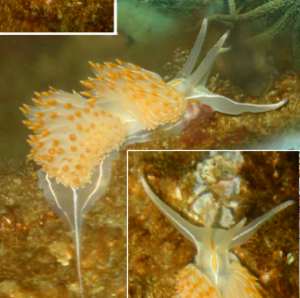
Dear Jan,
I'm afraid there are still plenty to go before this site has 'everything'. I would be happy to include Flabellina pricei if someone has photos to share.
I have enlarged a couple of the photos on your montage and they show a couple of features which are typical of Hermissenda crassicornis. Forstly, there are the white submarginal lines on the foot and the white median line down the 'tail'. And secondly, there is an the orange patch, outlined in white, just behind the head. I have never seen this species alive so I could be wrong, but I don't know of anything else that looks like this
Best wishes,
Bill Rudman
Re: Janolus fuscus from Puget Sound
July 6, 2005
From: Jeff Goddard
Hi Bill,
The specimen in Jack Connick's photo [message #14142 ] is Hermissenda crassicornis. Janolus fuscus never has a bluish white line on the foot, nor white stripes on the cerata, and is not known to eat cnidarians. One color form of Hermissenda consistently has a white stripe on each ceras (e.g., see photo by Glen Miller and Jackie Hildering in their message #11055). Hermissenda is also a generalist and opportunistic predator quite capable of feeding on scyphozoans if it can reach them; I once found specimens with bright blue guts in the process of feeding on the chondrophore Velella velella stranded in tidepools.
Without a good view of the head or dorsal surface, these two species can be confused for each other.
Best wishes,
Jeff Goddard
goddard@lifesci.ucsb.edu
Goddard, J.H.R., 2005 (Jul 6) Re: Janolus fuscus from Puget Sound. [Message in] Sea Slug Forum. Australian Museum, Sydney. Available from http://www.seaslugforum.net/find/14196Thanks Jeff,
I felt something was wrong with either the identification or the food. I forgot about the ubiquitous Hermissenda!
Best wishes,
Bill Rudman
Re: Janolus fuscus from Puget Sound
July 2, 2005
From: Jack Connick
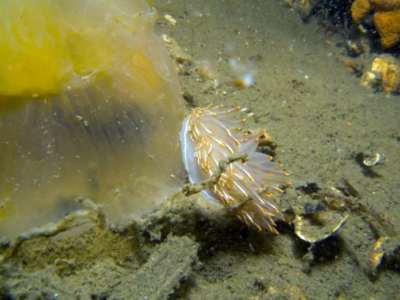
I haven't seen Janolus fuscus here either, certainly the first time at this site. Also interesting was that it was eating a chunk of Lion's Mane Jellyfish.
Locality: Seacrest Park, Cove 2, Puget Sound, Washington, USA. Pacific coast. Depth: 100 feet. Length: 3 ins. 26 June 2005. Photographer: Jack Connick
Jack
JackConnick@Yahoo.com
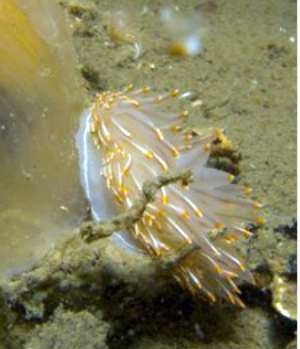
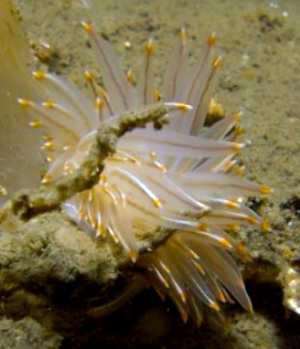
Dear Jack,
Thanks for the record. I wonder if it was eating the jellyfish or just crawling on it? As far as I know it feeds on certain arborescent bryozoans, so a shift to a cnidarian would be quite unusual
Best wishes,
Bill Rudman
Re: Nudibranch eggs will travel
May 9, 2005
From: Marli Wakeling
Hi Bill,
Concerning your comment [#13718]
It's more than likely the eggs were put there by the decorator crab as camouflage.
Cheers,
Marli
scubamarli@excite.com
Wakeling, M., 2005 (May 9) Re: Nudibranch eggs will travel. [Message in] Sea Slug Forum. Australian Museum, Sydney. Available from http://www.seaslugforum.net/find/13726Dear Marli,
Of course!
Best wishes,
Bill Rudman
Nudibranch eggs will travel
May 7, 2005
From: Marli Wakeling
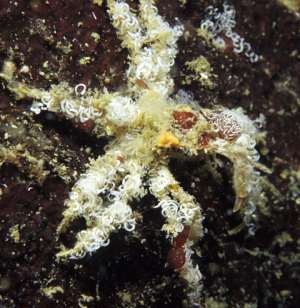
Hi Bill,
I have seen lots of interesting things on decorator crabs, but this is a first. I guess if you're as slow as a slug, this little guy is just the ticket to get your genetic material to a new locale! I think it's a Graceful decorator crab, Oregonia gracilis, but there's so much stuff on him, I can't say for sure. The eggs look like Hermissenda crassicornis egg strands.
Locality: Halkett Wall, Howe Sound, British Columbia, Canada. Pacific Coast. Depth: 35 feet. 01 June 2004. Mixed sand and shell bottom. Photographer: Marli Wakeling
Cheers,
Marli
scubamarli@excite.com
Wakeling, M., 2005 (May 7) Nudibranch eggs will travel. [Message in] Sea Slug Forum. Australian Museum, Sydney. Available from http://www.seaslugforum.net/find/13718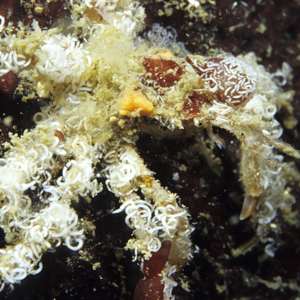
Thanks Marli,
It's certainly an interesting place to lay your eggs!
Best wishes,
Bill Rudman
Re: Raising Hermissenda for research
May 6, 2005
From: Ray Izumi
Concerning message #13656:
Look at "The sea slug, Hermissenda crassicornis: phylogeny, mariculture, and use as a model system for neurobiological research on learning and memory", at:
http://hermes.mbl.edu/BiologicalBulletin/MMER/KUZ/KuzTit.html
Ray Izumi
izumirm@sprynet.com
Izumi, R.M., 2005 (May 6) Re: Raising Hermissenda for research. [Message in] Sea Slug Forum. Australian Museum, Sydney. Available from http://www.seaslugforum.net/find/13721Thanks Ray,
I should have done what I urge others to do - look through the previous relevant messages! I forgot I posted this excellent reference 4 years ago [message #3808]
Best wishes,
Bill Rudman
Raising Hermissenda for research
April 29, 2005
From: Daniel Swezey
Hello-
I'm raising ~40 Hermissenda crassicornis for an undergraduate research project. Each Hermissenda is housed individually in a smally plastic tuper wear container with 15 holes poked in it. The containers are in a small tank immersed in water with a two-way fresh sea water flow system. They nudibranchs had been doing fine until recently when I've been getting slight die off. Over a period of a week, I've had 10 individuals slowly die in their containers (I find them turned on their sides with cerata fallen off in a clump). I can't correlate this death with size, position in the tank etc. as it seems totally random.
Does anyone have any ideas/advice for raising these animals? I've been feeding them fish food pellets (which is listed in the primary literature as a viable food) with a protein concentration of 40%. They had been doing fine for 2 weeks, and only recently have I had this problem. Any insight/information is greatly appreciated!
Daniel Swezey
solardan@umail.ucsb.edu
Swezey, D.S., 2005 (Apr 29) Raising Hermissenda for research. [Message in] Sea Slug Forum. Australian Museum, Sydney. Available from http://www.seaslugforum.net/find/13656Hermissenda crassicornis Cannibalism?
February 28, 2005
From: Daniel Swezey
Does Hermissenda crassicornis cannibalise- and in what situations might it cannibalise? I'm an undergraduate at the Univeristy of California, Santa Barbara, USA hoping to carry out some density dependence research studies based on cannibalism in Hermissenda crassicornis.
Thanks!
Daniel Swezey
solardan@umail.ucsb.edu
Swezey, D.S., 2005 (Feb 28) Hermissenda crassicornis Cannibalism?. [Message in] Sea Slug Forum. Australian Museum, Sydney. Available from http://www.seaslugforum.net/find/13219Dear Dan,
Quite a few glaucid aeolids seem to eat their own kind on some occasions, and I'm pretty sure Hermissenda crassicornis does. Have a look at the references listed on the species' Fact Sheet, and at the information conatined in the many messages concerning that species on the Forum. I am sure visitors to the Forum would be interested in progree reports on your studies.
Best wishes,
Bill Rudman
Hermissenda crassicornis with eggs
February 10, 2005
From: Bruce Wight

Hi Bill,
While at at the oil Rigs off San Pedro, California, USA for the first time in April 2004 I found this Hermissenda crassicornis with eggs
Take care,
Bruce Wight
bruce.c.wight@boeing.com
Wight, B.C, 2005 (Feb 10) Hermissenda crassicornis with eggs. [Message in] Sea Slug Forum. Australian Museum, Sydney. Available from http://www.seaslugforum.net/find/12947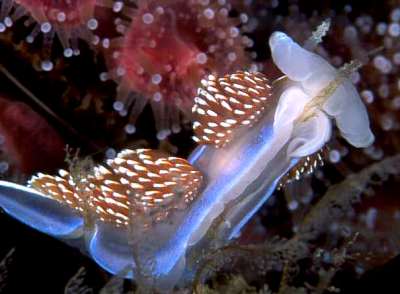
Thanks Bruce,
It's nice to get a good photo of the egg ribbons, and your second photo shows the foot very well
Best wishes,
Bill Rudman
Hermissenda crassicornis from California
August 9, 2004
From: Bruce Wight
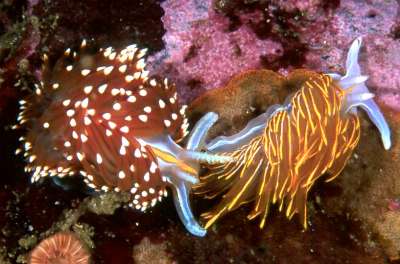
Hi Bill,
Here is a photos showing to colour variants of Hermissenda crassicornis I took on a trip to San Miguel Island [Channel Ids, California] in July 2004.
Bruce Wight
bruce.c.wight@boeing.com
Wight, B., 2004 (Aug 9) Hermissenda crassicornis from California. [Message in] Sea Slug Forum. Australian Museum, Sydney. Available from http://www.seaslugforum.net/find/12712Thanks Bruce,
Bill Rudman
Trailing behaviour in Hermissenda crassicornis
December 22, 2003
From: Marli Wakeling
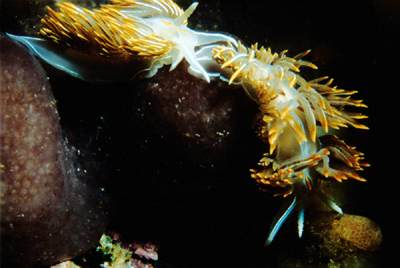
Hi Bill,
I had meant to send this to you a while ago, and just came across it again. These two large specimens of Hermissenda crassicornis were found exhibiting trailing behaviour as I have seen in Indo-Pacific species. I watched them for quite some time, and they were moving a quite a clip (for a nudibranch!). I've never seen this behaviour with this species before.
Dive Site: Snowflake
Location: Port Hardy, British Columbia, Canada
Date: August, 2003
Depth: 40 feet
Size: 4 cm.
Cheers,
Marli Wakeling
scubamarli@excite.com
Wakeling, M., 2003 (Dec 22) Trailing behaviour in Hermissenda crassicornis. [Message in] Sea Slug Forum. Australian Museum, Sydney. Available from http://www.seaslugforum.net/find/11719Thanks Marli,
There has been quite a bit of behavioural work done on this species so perhaps someone can let us know if this is a common occurrence. It's not usual for aeolids to follow mucus trails like this but I suppose a species with such a broad diet as Hermissenda crassicornis, including other nudibranchs, would find the ability to 'trail' a useful behaviour
Best wishes
Bill Rudman
Hermissenda - 1000 miles from land
November 15, 2003
From: Hiroaki Sakoh


Dear Bill,
I am a research scientist at the Mutsu Institute for Oceanography / Japan Marine Science and Technology Center. My speciality is primary production and low level food web in aquatic ecosystem. At present I am engaged in research of the carbon cycle of the northwest North Pacific. Moreover, my hobby is diving.
I would be grateful for some comments on this sea slug obsservation I have made.
I collected these animals slug from a mooring system moored in the northwestern North Pacific for one year. The mooring system was positioned at about 39N and 160E.
The depth of water of the place is about 5450m and the top depth of the mooring system was about 30m.
I collected four sea slugs from the top of an instrument moored at about 40m depth. It seems that these sea slugs are all of the same kind and I think they are probably Hermissenda crassicornis. Would you agree?
This mooring point is situated in the the Kurosiwo extension Current. However, the place is about a thousand nautical miles from the shore. I think that the adult sea slugs of this kind cannot swim long distances. If that is so I suspect the veliger larva were transported there by the Kuroshio Current. The speed of Kuroshio Current is 1-5 Knots. If the average speed of the current is 2 Knots, they would have taken at least 20 days to drift there.
Can they live as planktonic veliger larva for 20 days or more? I hear that Hermissenda crassicornis has a very large distribution from the Pacific coast in the United States to Japan. Did they settle down as they migrated from the west coast to the east coast of the Pacific Ocean? Is this an unusual observation? I woulod be grateful for your comments.
Sincerely yours,
Hiro
Hiroaki SAKOH
Mutsu Institute for Oceanography
Japan Marine Science and Technology Center
690 Kitasekine, Sekine,
Mutsu, Aomori, 035-0022 Japan
sakoh@jamstec.go.jp
Sakoh, H., 2003 (Nov 15) Hermissenda - 1000 miles from land. [Message in] Sea Slug Forum. Australian Museum, Sydney. Available from http://www.seaslugforum.net/find/11419
Dear Hiro,
Your animals are Hermissenda crassicornis, and as you suggest, they must have got to your mooring floats as larvae. If you have a look at the Hermissenda Fact Sheet, and in the attached messages, you will find quite a few references to the biology of this species.
The best place to look for information on larval biology, however, would be the Woods Hole Marine Biological Laboratory web site at: http://hermes.mbl.edu/BiologicalBulletin/MMER/KUZ/KuzTit.html
[Alan M. Kuzirian, Tom Capo, Donna McPhie, and Catherine T. Tamse. The sea slug, Hermissenda crassicornis: phylogeny, mariculture, and use as a model system for neurobiological research on learning and memory. [The Marine Biological Laboratory, Woods Hole, MA 02543]]
You will see there that the planktonic larvae have a mimimum 30 day planktonic stage before settlement. Settlement can be delayed until about 76 days but few can metamorphose successfully after 50 days. So if your calculation of a minimum travel time of 20 days is correct, then they certainly could travel the distance. Concerning your question about whether these may have stopped off on a migration from Japan to Nth America it's important to distinguish migration from geographic distribution. While birds and fish may undertake great distance migrations each year, the same cannot be said for small invertebrates. Present day distributions are most likely the result of slow incremental expansion from an initial origin. Perhaps now and then a few lucky larva may drift a long distance and make a quick expansion in geographic range but that would depend on more than one larva arriving at the same spot at the same time, finding an appropriate food source, settling together, and reaching reproductive maturity. This would involve a lot of luck.
Observations such as yours are rare, so I am very grateful you are willing to share it with us. Hopefully other contributors to the Forum will add further comments or similar observations
Best wishes
Bill Rudman
Hermissenda crassicornis feeding
September 30, 2003
From: Glen Miller and Jackie Hildering
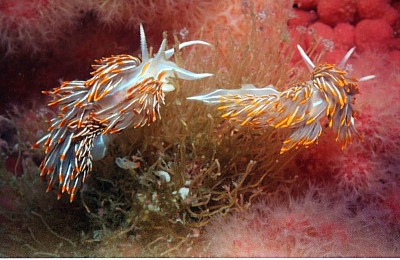

Dear Bill,
Just wanted to share this photo of Hermissenda crassicornis feeding on the hydroid Ectopleura marina with you. Hermissenda crassicornis appears to be an occassional species in our area.
Dive: Snowflake Island, Browning Pass, British Columbia, CANADA
Depth: 40'
Best wishes
Glen Miller and Jackie Hildering
earthent@telus.net
Miller, G. & Hildering, J., 2003 (Sep 30) Hermissenda crassicornis feeding. [Message in] Sea Slug Forum. Australian Museum, Sydney. Available from http://www.seaslugforum.net/find/11055Thanks Glen & Jackie,
Bill Rudman
Hermissenda crassicornis without cerata
August 14, 2003
From: M.J. Adams

Hi,
We found what we believe to be Hermissenda crassicornis low in an intertidal area on Whidbey Island, Washington State (USA). It was missing almost all of its cerata. There was a steady downpour of rain when we found it and we're wondering if the fresh water from the rain would be enough to make it lose its cerata.
Thank you.
Mary Jo
mjadams52@hotmail.com
Adams, M.J., 2003 (Aug 14) Hermissenda crassicornis without cerata. [Message in] Sea Slug Forum. Australian Museum, Sydney. Available from http://www.seaslugforum.net/find/10703Dear Mary Jo,
It's quite possible that if it was immersed in or even half covered in freshwater it would drop its cerata. While some aeolids, such as species of Phyllodesmium regularly drop cerata as a defensive strategy [see Autotomy Page], most don't except in extreme circumstances. It unfortunately often occurs when we are trying to preserve specimens.
Best wishes,
Bill Rudman
Hermissenda crassicornis from the Channel Ids, California
August 5, 2003
From: Bruce Wight
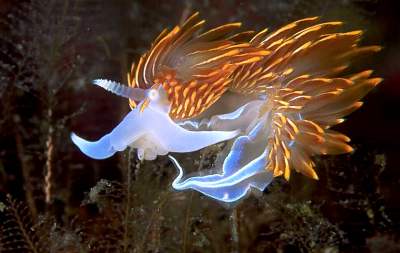
Dear Bill,
Johanna and I saw lots of great natural behavior on last weekends dive trip out to San Miguel Island [Channel Islands National Park, California - July 2003]. Here is one of a series of messages showing some images I took during the two day trip.
These photos are of a vivid Hermissenda crassicornis feeding on hydroids.
Best wishes,
Bruce Wight
bwproductions@earthlink.net
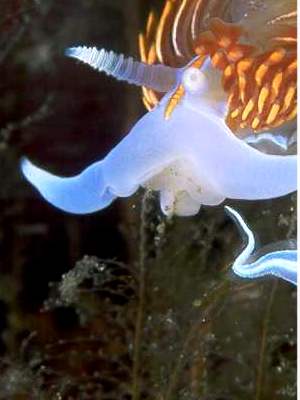
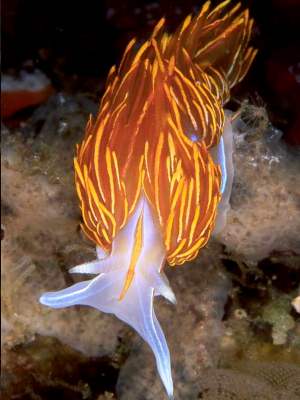
Thanks Bruce,
This is a good exampe of this colour form with a white/yellow line on the cerata
Bill Rudman.
Hermissenda crassicornis from California
August 1, 2003
From: Chris Grossman


Dear Bill
I took this photo of the very common Hermissenda crassicornis on July 19, 2003 on the North side of Sutil Island, at Santa Barbara Island, California, USA.
Chris Grossman
seaslugforum.net@diver.net
Grossman, C., 2003 (Aug 1) Hermissenda crassicornis from California. [Message in] Sea Slug Forum. Australian Museum, Sydney. Available from http://www.seaslugforum.net/find/10610Thanks Chris,
Bill Rudman
Re: Update on Hermissenda ailments
July 30, 2003
From: Rosemary Romero
Dear Ian,
Concerning the messages about sick Hermissenda. I'm an undergraduate at the University of California, Santa Cruz and am working with Hermissenda crassicornis for my senior thesis. I don't know how to "get rid" of the bubbles but I have observed these gas bubbles after transferring slugs from one container to another using a paint brush, I now use a ladle and find that this alleviates the problem. I noticed that Dr. Rudman cited two species that like to float upside down at the water surface; I too have noticed this with the Hermissenda that I'm using in my experiments.
Best wishes,
Rosemary Romero
rromero@ucsc.edu
Romero, R., 2003 (Jul 30) Re: Update on Hermissenda ailments. [Message in] Sea Slug Forum. Australian Museum, Sydney. Available from http://www.seaslugforum.net/find/10497Thanks Rosemary,
It is strange that using a paint brush causes bubbles to develop inside the animal. Perhaps the bristles puncture the skin of the animal? Concerning animals upside down oon the water surface. What you are probably observing is your animals crawling along upside down on the surface film. Many nudibranchs and snails do this in aquaria and in rock pools at low tide. It is quite different from Glaucus and Glaucilla which truly float.
Best wishes,
Bill Rudman
Update on Hermissenda ailments
July 18, 2003
From: Ian Dow
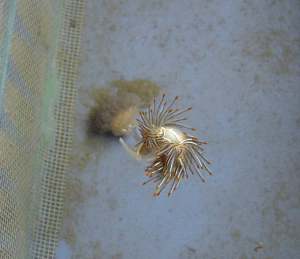
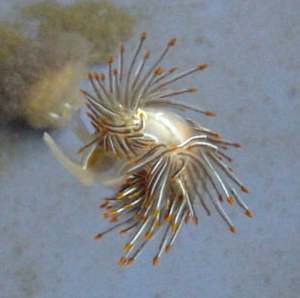
Dr. Rudman,
Concerning my earlier message: Though the source of the extra gas in the body cavities and cerata of my Hermissenda has yet to be determined, most of the slugs seem to be improving slowly. As suggested by Mr. van Bragt here is a picture of one of them floating on the surface, though the gas bubbles in the body cavity are not very discernible. It seems that the ones who ended up with the bubbles in their cerata died, while the ones with the bubbles mainly in their body cavity survive, and slowly deflate. Again, thank you Dr. Rudman and everyone else who has offer any advice. If anyone comes up with anything, please let me know.
Best Regards,
Ian Dow
dowim@eckerd.edu
Dow, I., 2003 (Jul 18) Update on Hermissenda ailments. [Message in] Sea Slug Forum. Australian Museum, Sydney. Available from http://www.seaslugforum.net/find/10478Re: Ailments in Hermissenda crassicornis
July 17, 2003
From: Kathe R. Jensen
Dear Bill & Ian,
I have seen this phenomenon of gas bubbles "trapped" in the bodies of laboratory sacoglossans (and I think also in some nudibranchs). Although I don't know the cause of it, I suspect that in sacoglossans it is due to excessive oxygen production by symbiotic chloroplasts. However, as you have noticed, it tends to prevent the animals from staying below the water surface, and in my experience the animals die within a few days - probably of exhaustion from trying to get under the water surface.
Greetings,
Kathe
krjensen@zmuc.ku.dk
Jensen, K.R., 2003 (Jul 17) Re: Ailments in Hermissenda crassicornis. [Message in] Sea Slug Forum. Australian Museum, Sydney. Available from http://www.seaslugforum.net/find/10465Thanks Kathe,
It is a very strange phenomenon,
Bill Rudman.
Ailments in Hermissenda crassicornis
July 16, 2003
From: Ian Dow
Dear Dr. Rudman,
I am currently conducting an prey preference test with some Hermissenda crassicornis that were collected on the nets of fish pens in the San Juan Islands in Washington. Today I noticed that there were some rather odd "bulges" in some of their cerata, almost like gas bubbles. Later in the day, I noticed these bubbles were also in the body cavities of the slugs and were causing them to become buoyant and float on the water surface. While my advisor and I have yet to determine the exact source of this extra oxygen, we are concerned for the health of the slugs. Have you ever heard of or seen this condition before? And if so, is there anything I can do in terms of care and maintenance to keep the slugs alive? Any thoughts or suggestions would be greatly appreciated.
Best Regards,
Ian Dow
dowim@eckerd.edu
Dow, I., 2003 (Jul 16) Ailments in Hermissenda crassicornis. [Message in] Sea Slug Forum. Australian Museum, Sydney. Available from http://www.seaslugforum.net/find/10455Dear Ian,
I won't make any flatulence jokes. I guess when you say 'extra oxygen' you mean extra gas, as it could be carbon dioxide or some other gas. I can't say I have ever heard of this happening in any captive opisthobranch, but as Hermissenda crassicornis is quite a popular laboratory animal perhaps someone will have experienced this phenomenon before and will let us know. Clearly there is something wrong with these animals.
Of course two related species, Glaucus atlanticus and Glaucilla marginata, have a permanent gas bubble in their gut which enables them to float upside down at the water surface.
Hopefully you will be able to get some more animals and continue your research. I would be interested in a progress report,
Best wishes,
Bill Rudman
Hermissenda from California
October 17, 2002
From: Bruce Wight
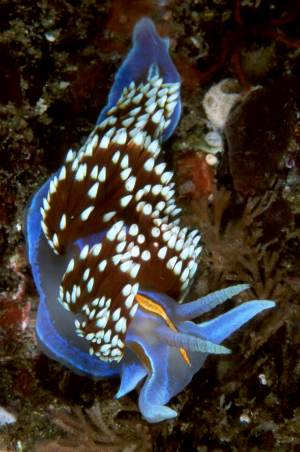
Hi Bill,
Here is a photo of Hermissenda crassicornis I took on a three day trip out to Anacapa and Santa Barbara Islands, California [September 2002]. Dive conditions were pretty bad with heavy surge and current in most of the areas we dove. There were a great many Tritonia festiva out on the South end of Anacapa in about 40-50 feet depth.
Bruce Wight
bwproductions@earthlink.net
Wight, B., 2002 (Oct 17) Hermissenda from California. [Message in] Sea Slug Forum. Australian Museum, Sydney. Available from http://www.seaslugforum.net/find/8189
Thanks Bruce,
The close-up of the head shows details of its morphology and colour pattern very well
Best wishes,
Bill Rudman
Hermissenda crassicornis from British Columbia
October 10, 2002
From: Marli Wakeling
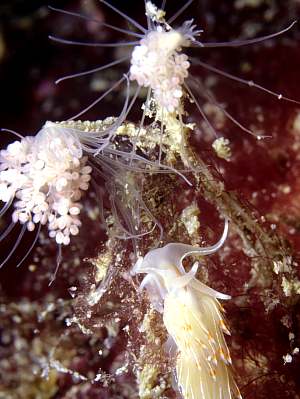
Hi Bill,
Here is a really pale Hermissenda crassicornis from Howe Sound, near Vancouver, British Columbia, Canada. It is perched and looking to be about to eat some solitary hydroids, Tubularia harrimani.
Location: Bowyer Island, Howe Sound British Columbia
Date:August, 2002
Depth:35 feet
Length:10mm
Photograph: Marli Wakeling
Regards,
Marli Wakeling
scubamarli@excite.com
Wakeling, M., 2002 (Oct 10) Hermissenda crassicornis from British Columbia. [Message in] Sea Slug Forum. Australian Museum, Sydney. Available from http://www.seaslugforum.net/find/8133
Thanks Marli,
I must say it looks very brave - or very foolish - to be crawling up so close to those stinging tentacles of Tubularia.
Best wishes,
Bill Rudman
Hermissenda crassicornis from San Miguel, Calif.
August 12, 2002
From: Bruce Wight

Dear Bill,
Here is another photo from our trip to San Miguel Island, California [July 2002]. It is of some juvenile Hermissenda feeding on the hydroids which covered the stalks of the palm kelp.
Thanks,
Bruce Wight
bwproductions@earthlink.net
Wight. B., 2002 (Aug 12) Hermissenda crassicornis from San Miguel, Calif.. [Message in] Sea Slug Forum. Australian Museum, Sydney. Available from http://www.seaslugforum.net/find/7709Thanks Bruce,
Bill Rudman
Looking for photos of Hermissenda veligers
July 22, 2001
From: G. Sparks
I've been scanning the web, and texts, looking for photos of Hermissenda crassicornis veligers. I'm interested in the daily changes in the look of the veliger. In the lab they seem to die after about ten days. Shouldn't they metamorphose at that time?
G. Sparks
MrGSparks1@aol.com
Sparks, G., 2001 (Jul 22) Looking for photos of Hermissenda veligers. [Message in] Sea Slug Forum. Australian Museum, Sydney. Available from http://www.seaslugforum.net/find/4882Dear Mr Sparks,
Have a look at my earlier message. If you go to the Wood's Hole site mentioned there you should find all you need to know about Hermissenda larval culture.
Best wishes,
Bill Rudman
Hermissenda crassicornis question
June 12, 2001
From: Robert Baker
Hi,
In a tank of nudibranchs and moon jellies there are some white opaque objects that look like the spirals from a spiral notebook that are themselves wound in the form of a spiral about three inches in diameter. What are these? Egg sacks?
Robert Baker
rbaker1@lausd.k12.ca.us
Baker, R., 2001 (Jun 12) Hermissenda crassicornis question. [Message in] Sea Slug Forum. Australian Museum, Sydney. Available from http://www.seaslugforum.net/find/4560Dear Robert,
You mention Hermissenda crassicornis in the title of your message so I guess those are the 'nudibranchs' you have in your aquarium. Your 'spirals' certainly sound like the egg ribbon of Hermissenda. Have a look at the photo of its egg ribbon at the top of this page. The Forum is much more than just a question and answer page. Have a look at the other messages attached below yours on this H. crassicornis page for more information. For moving around the Forum click on anything underlined and use the buttons at the top and bottom of every page to go to the Species List, General Topics List, the SEARCH box, etc.
Best wishes,
Bill Rudman
Information on Hermissenda crassicornis
February 17, 2001
From: Bill Rudman
Just found this useful information on the Woods Hole Marine Biological Laboratory web site at http://hermes.mbl.edu/BiologicalBulletin/MMER/KUZ/KuzTit.html [The Marine Biological Laboratory, Woods Hole, MA 02543]
• Alan M. Kuzirian, Tom Capo, Donna McPhie, and Catherine T. Tamse.
The sea slug, Hermissenda crassicornis: phylogeny, mariculture, and use as a model system for neurobiological research on learning and memory.
Bill Rudman
Rudman, W.B., 2001 (Feb 17) Information on Hermissenda crassicornis. [Message in] Sea Slug Forum. Australian Museum, Sydney. Available from http://www.seaslugforum.net/find/3808Variation in Hermissenda crassicornis
August 4, 2000
From: Bruce Wight

Dear Bill,
Johanna and I were on a two day trip to San Miguel Island off Santa Barbara, California and it was branch city!. We were diving in about 60 feet of water which was a cool 53 degrees. I have never seen so many vivid Hermissenda crassicornis. There were three distinct color types; normal, vivid copper and plain with just copper tipped cerata. Check out the attached images. Velvia film doesn't do them justice. Also, got a shot of a normal colored one laying pinkish eggs, I always thought their eggs were white. Maybe over time they turn white. There were also many other species of nudibranchs, at least a dozen, we saw both the white and the yellow color variations in the Diaulula as well.
Bruce Wight.
bwproductions@earthlink.net
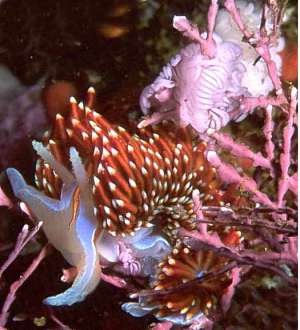
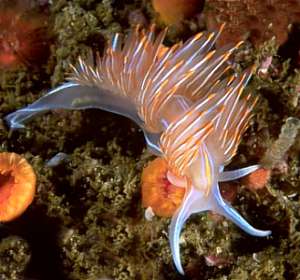
Thanks Bruce,
They are spectacular animals, although from Andy's message today, if you are farming geoducks they may not be your favourite nudibranch.
Best wishes,
Bill Rudman.
Hermissenda crassicornis feeding on Geoducks?
August 4, 2000
From: Pacific Shellfish Institute
Recently we were informed about a high geoduck mortality at a few sites around the South Puget Sound of Washington State. These Geoducks were planted recently this year so their shell size ranged from 5 to 12 mm. Samples were collected on 2 August 2000 and sea slugs, determined to be Hermissenda crassicornis, were found in higher than normal numbers at the site. The Geoducks were planted in trays, so there is little or no substrate, at intertidal level. If anyone has information on Sea Slugs or even Hermissenda crassicornis feeding off of seed Geoducks or other similar molluscs please let us know.
[Note: For those of you who may be wondering if geoducks quack or lay eggs, 'geoduck' is a name for a large North American burrowing edible bivalve (Panopea generosa, SF: Hiatelloidea). - Bill Rudman]
Thanks,
Andy Suhrbier
Pacific Shellfish Institute
PSInstitute@uswest.net
Suhrbier, A., 2000 (Aug 4) Hermissenda crassicornis feeding on Geoducks?. [Message in] Sea Slug Forum. Australian Museum, Sydney. Available from http://www.seaslugforum.net/find/2833Dear Andy,
Hermissenda crassicornis certainly seems to have quite a catholic diet and there have been quite a few studies on the subject. Have a look at Cesar Megina's message on the topic. Bivalves, or pieces of bivalves are readily eaten by captive animals. Have a look at two recent papers for references to its food preferences.
• Avila, C. (1999) Chemotaxis in the nudibranch Hermissenda crassicornis: does ingestive conditioning influence it behaviour in a Y-maze? Journal of Molluscan Studies, 64: 215-222
• Avila, C., Tyndale, E., & Kuzirian, A.M. (1998) Feeding behaviour and growth of Hermissenda crassicornis (Mollusca: Nudibranchia) in the Laboratory. Mar. Fresh. Behav. Physiol., 31: 1-19.
Bill Rudman.
Rudman, W.B., 2000 (Aug 4). Comment on Hermissenda crassicornis feeding on Geoducks? by Pacific Shellfish Institute. [Message in] Sea Slug Forum. Australian Museum, Sydney. Available from http://www.seaslugforum.net/find/2833Hermissenda crassicornis from California
July 15, 2000
From: Bruce Wight


Dear Bill,
Regarding the March discussion, on Hermissenda crassicornis, I have seen many of them together and have never seen them acting aggressively towards each other. I have attached two photos of a couple of beautifully translucent ones I photographed in June of this year at San Clemente Island, California. There is one local aeolid however, that is very aggressive towards others of its own kind, and that is
Phidiana hiltoni (formerly Phidiana pugnax), which I have sent a message about separately.
Take care,
Bruce Wight
bwproductions@earthlink.net
Wight, B., 2000 (Jul 15) Hermissenda crassicornis from California. [Message in] Sea Slug Forum. Australian Museum, Sydney. Available from http://www.seaslugforum.net/find/2714Dear Bruce,
Thanks for the photos.
Bill Rudman.
Hermissenda Mating Preferences...
March 6, 2000
From: Ty Lim
Hi, my name is Ty Lim and I'm a senior in high school. As you know, Hermissenda is an hermaphrodite; however, I am trying to conduct an experiment to test if exuded pheromones play a role and whether olfactory or tactile cues are responsible for attractive behavior. I have followed up the literature you suggested.
I am in Southern California, Long Beach to be exact, and if there is anyone out there who could help me design an experiment, and knows of a laboratory close by that could accommodate my needs, please let me know. I'm in dire need of help, and any help would be appreciated.
Thank you.
Ty Lim
Just2Tyght@yahoo.com
Lim, T., 2000 (Mar 6) Hermissenda Mating Preferences.... [Message in] Sea Slug Forum. Australian Museum, Sydney. Available from http://www.seaslugforum.net/find/2038Dear Ty,
Let's hope someone out there can help you.
let me know if you have any success.
Best wishes,
Bill Rudman.
Re: Hermissenda
February 20, 2000
From: Max O'Brien
I want to thank you for all the help. It was great and so fast. Thank you very much.
Also you guessed right it was the Hermissenda crassicornis.
Max.
gotomax@worldnet.att.net
O'Brien, M., 2000 (Feb 20) Re: Hermissenda. [Message in] Sea Slug Forum. Australian Museum, Sydney. Available from http://www.seaslugforum.net/find/1935Re: mating information
February 16, 2000
From: Ty Lim
Dear Dr. Rudman,
Thank you for your much needed information. I will promptly start on the research papers and will keep you posted on my findings.
Sincerely,
Ty Lim
just2tyght@yahoo.com
Lim, T., 2000 (Feb 16) Re: mating information. [Message in] Sea Slug Forum. Australian Museum, Sydney. Available from http://www.seaslugforum.net/find/1921Mating behaviour in Hermissenda
February 15, 2000
From: Ty Lim
Hi,
I am a high school senior at Long Beach Polytechnic High, and I am doing a research project on whether animals of Hermissenda crassicornis can show a sexual preference. I know that they are hermaphrodites, but I was wondering if there was any research or experiment that had already been done to test what I'm testing. I have a hunch that it may have something to do with their muco-polysaccharides, but I'm not sure. If anyone can help, I'd greatly appreciate any information.
Thank you.
Ty Lim
Just2Tyght@yahoo.com
Lim, T., 2000 (Feb 15) Mating behaviour in Hermissenda. [Message in] Sea Slug Forum. Australian Museum, Sydney. Available from http://www.seaslugforum.net/find/1900Dear Ty,
I know of two research papers on mating behaviour in Hermissenda. They show that although 'pairing' and 'alignment' can take up to 30 minutes or more, actual copulation is over in 1 or 2 seconds. There doesn't seem to be any evidence of 'gender choice' both partners rapidly swapping sperm.
I am sure if there are later papers someone will let us know. Both these references should be available in a university library. I guess Long Beach is in California? If so you also have some good natural history museums which probably have both journals in their libraries.
Good Luck with your project. Perhaps you could send us a summary of your findings.
Best wishes,
Bill Rudman.
References:
•Longley, R.D. & Longley, A.J. (1981) Hermissenda: agonistic behaviour or mating behaviour? The Veliger 24(3):, 230-231.
•Rutowski, R.L. (1983): Mating and egg mass production in the aeolid nudibranch Hermissenda crassicornis (Gastropoda: Opisthobranchia). Biological Bulletin, 165(August): 276-285.
Finding out what I see under water
February 7, 2000
From: Max O'Brien
Hi,
I live in Ventura, California. I have been diving lately and just saw something I don't know what is under water. It's an aeolid nudibranch that is a clearish white with a neon blue stripe down its back and brownish cerata. I hope this isn't too little info, but it's all I can come up with since my pictures didn't come out.
Also do you know of any other places to find common names to go with the scientific names
Thanks for all the help,
Max O'Brien
gotomax@worldnet.att.com
O'Brien, M, 2000 (Feb 7) Finding out what I see under water. [Message in] Sea Slug Forum. Australian Museum, Sydney. Available from http://www.seaslugforum.net/find/1859Dear Max,
I can't pretend to be an expert on Californian nudibranchs but one quite common aeolid that fits your description would be Hermissenda crassicornis. Can you remember if your animal looked anything like the photo in the Forum, at the Top of this Page? Have a look at the Cerata Page to find out about the aeolid cerata.
I'm afraid most nudibranchs don't have common names. You will find what are called "common names" in some books but they are usually made up for that book and so aren't commonly used and are probably different from the common names in any other book. If you look at some of the long 'scientific' names used by gardeners for common flowers, then scientific names aren't that difficult to use. The basic rule is that your should use both names - in this case Hermissenda crassicornis. If you start talking about having found a "Hermissenda" or a "crassicornis" it's a bit like saying "George was President of the USA" - no-one will know if your are talking of George Bush or George Washington or your friend George down the street.
If you get your camera working, I'd like to see some of your finds .. and if your animal isn't Hermissenda crassicornis let me know and we will see if some of our Californian participants can help.
Best wishes,
Bill Rudman.
Source for Hermissenda crassicornis on E. coast
October 16, 1999
From: David Chan
I'm an aquatic biologist at the Steinhart Aquarium in San Francisco. I have recently been told that there is a laboratory on the east coast which raises Hermissenda crassicornis through the life cycle for research purposes. I am would like to know if anyone can verify this and if so, has a contact number. Thanks in advance for any help.
Dave Chan
dchan@calacademy.org
Chan, D., 1999 (Oct 16) Source for Hermissenda crassicornis on E. coast. [Message in] Sea Slug Forum. Australian Museum, Sydney. Available from http://www.seaslugforum.net/find/1426Re: Hermissenda feeding
July 22, 1999
From: Cesar Megina
Hello, Benjamin...and everybody:
Probably Conchita Avila, may help you better, but, as far as I know, they can be fed with many different (and surprising) foods, such as pieces of squid or pieces of mussels, as well as with hydroids (Tubularia has been used, but probably many others are suitable), anemones and ascidians. Conchita found that anemones (Haliplanella luciae and Metridium senile) are good food for adults, although juveniles grow better with Tubularia.
Reference: Avila, C., Tyndale, E. and Kuzirian, A.M. (1998) Feeding behaviour and growth of Hermissenda crassicornis (Mollusca: Nudibranchia) in the Laboratory. Mar. Fresh. Behav. Physiol., 31: 1-19).
My experience is in field diet, and it depends on prey community composition. In several harbours we studied in California, the main prey is an ascidian (Aplidium solidum), preferred even to hydroids (Campanularia and Obelia) or anemones. It is also possible to find many other prey, mainly hydroids and, in a lesser proportion, remains of anthozoans (Corinactis, Metridium).
Considering these field data, a good diet may be a colonial ascidian, easy to bite for them (without any especially difficult defensive system, such as a hard cover, or toxic...), complemented with a small quantity of a hydroid. The species of ascidian and hydroids will depend on what you can find easily (you must experiment).
Anyway, if I were you I would ask Conchita Avila.
Good luck,
Cesar
University of Cadiz,
Spain
cesar.megina@uca.es
Megina, C., 1999 (Jul 22) Re: Hermissenda feeding. [Message in] Sea Slug Forum. Australian Museum, Sydney. Available from http://www.seaslugforum.net/find/1097Thanks Cesar,
I don't know why I didn't think of Conxita. At Menfi she gave me a number of interesting reprints, including the one you mention, on her work on Hermissenda at Woods Hole Laboratory, Massachusetts. Ben, her email address in Spain is conxita@ceab.csic.es.
Bill Rudman.
Re: Hermissenda feeding
July 21, 1999
From: Benjamin Ross
Thanks for the information.
Actually, I am doing research in Dr. Alkon's lab. I have talked with him about it as well as a few other sources. I was mainly curious to get an idea of the various food people use and what kind of success they have. I am interested in trying a few different feeding plans to see whether or not it affects my data.
Thanks again,
Ben
benjamin-ross@ouhsc.edu
Ross, B., 1999 (Jul 21) Re: Hermissenda feeding. [Message in] Sea Slug Forum. Australian Museum, Sydney. Available from http://www.seaslugforum.net/find/1094What is the best food for Hermissenda?
July 20, 1999
From: Benjamin Ross
I am a summer student working with Hermissenda and a few animals died in the aquarium after 2 weeks. Currently I am feeding them with Cichlid Gold by Hikari. Is there an alternate food which would be better for them? Also, I am curious as to their natural food source.
Thanks.
Benjamin Ross
benjamin-ross@ouhsc.edu
Ross, B., 1999 (Jul 20) What is the best food for Hermissenda?. [Message in] Sea Slug Forum. Australian Museum, Sydney. Available from http://www.seaslugforum.net/find/1088Dear Ben,
Hopefully someone with personal experience of this animal will respond to your question. Hermissenda crassicornis is a generalist feeder. It feeds on hydroids, such as Obelia and Tubularia, as you would expect for an aeolid, but has also been reported to feed on small crustacea, other nudibranchs, sea pens, ascidians and stranded jellyfish! Harrigan & Alkon (1978) raised specimens in the laboratory on the ascidian Ciona intestinalis, mantle muscles of the squid Loligo and the mussel Mytilus. Perhaps chopped up pieces of marine invertebrate tissue are worth a try.
Reference:
• Harrigan, J.F. & Alkon, D.L. (1978). Larval rearing, metamorphosis, growth and reproduction of the aeolid nudibranch Hermissenda crassicornis (Eschscholtz, 1831). Biological Bulletin, 154: 430-439.
If you could let us know what research you are doing with Hermissenda, perhaps someone visiting the Forum could give you some advice.
Bill Rudman.
Rudman, W.B., 1999 (Jul 20). Comment on What is the best food for Hermissenda? by Benjamin Ross. [Message in] Sea Slug Forum. Australian Museum, Sydney. Available from http://www.seaslugforum.net/find/1088Re: Use of name Hermissenda
June 23, 1999
From: Bill Rudman
Rudman, W.B., 1999 (Jun 23) Re: Use of name Hermissenda.
[Message in] Sea Slug Forum. Australian Museum, Sydney.
Available from http://www.seaslugforum.net/find/970
Following on Maria Byrne's earlier query about the correct name for Hermissenda crassicornis, I discussed this with colleagues at the Menfi workshop. The general consensus was that although Hermissenda is probably an unnecessary name, until the validity of the other related genera, such as Phidiana and Facelina, is determined, we might as well continue to use it. To change temporarily to either Phidiana or Facelina, or some other genera, would only be confusing.
Bill Rudman.
Correct genus for Hermissenda crassicornis
May 20, 1999
From: Maria Byrne
Hi Bill
Could you tell me the taxonomic status of Hermissenda crassicornis. I believe the genus is now Phidiana and would be grateful if you could confirm this.
All the best,
Maria
Department Anatomy and Histology F13
University of Sydney
NSW 2006
Australia
mbyrne@anatomy.su.oz.au
Byrne, M., 1999 (May 20) Correct genus for Hermissenda crassicornis. [Message in] Sea Slug Forum. Australian Museum, Sydney. Available from http://www.seaslugforum.net/find/877Dear Maria,
Your question gives me an opportunity to use a couple of Daniel Geiger's great photos. He has kindly sent me a set of photos from California and Europe which I will be able to use to illustrate questions and discussion topics.
I don't think there are any good characters separating Hermissenda from Phidiana but people tend to become attached to the names of their common animals. Most Californian literature still calls the animal Hermissenda crassicornis.
Could we have some guidance from the Californian experts? Are there good reasons for persisting with the name Hermissenda? Can you give me a recent reference?
Thanks,
Bill Rudman
